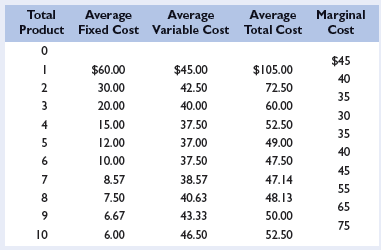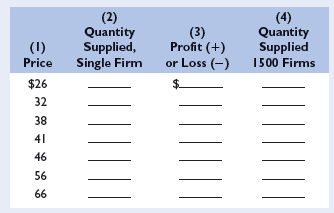Assume Following Cost Data Are Purely Competitive Producer Total Product Average Fixed Cost
Assume the following cost data are for a purely competitive producer.

Answer the questions in the first column in the table below for each of the prices listed at the top of each of the three columns;
Elevate Your Writing with Our Free Writing Tools!
Did you know that we provide a free essay and speech generator, plagiarism checker, summarizer, paraphraser, and other writing tools for free?
Access Free Writing ToolsA. At a product price of $56, will this firm produce in the short run? If it is preferable to produce, what will be the profit-maximizing or loss-minimizing output? What economic profit or loss will the firm realize per unit of output?
B. Answer the questions of 4a assuming product price is $41.
C. Answer the questions of 4a assuming product price is $32.
D. In the table below, complete the short-run supply schedule for the firm (columns 1 and 2) and indicate the profit or loss incurred at each output (column 3).

E. Now assume that there are 1500 identical firms in this competitive industry; that is, there are 1500 firms, each of which has the cost data shown in the table. Complete the industry supply schedule (column 4)
F. Suppose the market demand data for the product are as follows:

What will be the equilibrium price? What will be the equilibrium output for the industry? For each firm? What will profit or loss be per unit? Per firm? Will this industry expand or contract in the long run?
Get economics homework help from the leading service provider offering the best quality economics assignment help to aid students with their assignments.
Solution:
A. Yes; 8 units; the total economic profit equals $62.96.
The rule is to produce at the level of output where Marginal Revenue equals (or is greater than if we are using integers) Marginal Cost as long as revenue is sufficient to cover fixed cost (Price is greater than Average Fixed Cost).
In the case above the market is competitive so Marginal Revenue equals the price of $56. From the table above we see that the marginal cost for the 8th unit is $55 and the marginal cost of 9th unit is $65. The firm will want to produce 8 units where the marginal revenue of $56 is greater than the marginal cost of $55. For the 9th unit of output this is not the case. We also need to verify that price exceeds average variable cost at this level of production. The answer is yes, average variable cost is $40.63 which is less than the price of $56.
At this level of production the firm will earn a positive economic profit per unit of $7.87 (= $56 (price of product) – $48.13 (average total cost for the 8th unit). The total economic profit equals $62.96 (=8 (number of units sold) x $7.87 (profit per unit)).
B. Yes; 6 units; the total economic profit (loss) equals -$39.00.
The same process is applied here.
The price of $41, which is marginal revenue, is greater than the marginal cost of the 6th unit in the table above. Beyond this level of production marginal cost exceeds marginal revenue. Thus, the firm will produce 6 units as long as price covers average variable cost. The average variable cost for 6 units is $37.50, which is less than the price. The firm will produce the 6 units of output.
At this level of production the firm will earn a negative economic profit per unit or loss per unit of -$6.50 (= $41 (price of product) – $47.50 (average total cost for the 6th unit). The total economic profit (loss) equals -$39.00 (=6 (number of units sold) x (-$6.50) (loss per unit)).
C. The firm will not produce; the firm shuts down and incurs the loss of $60.00 (fixed cost)
We could go through the same exercise here. However, by recognizing that the price of
$32 is below average variable cost at all levels of production the firm will not produce. Thus, the firm shuts down and incurs the loss of $60.00 (fixed cost).
D and E.
Handled above using the third table
F. $46; 10,500; 7 units; per-unit loss is -$1.14; the loss per firm is -$7.98; industry will contract.
To determine the equilibrium price we look at the total quantity demanded schedule and the total quantity supplied schedule (for the 1500 firms above) to find the price where quantity demanded equals quantity supplied.
This occurs at the price of $46 where quantity demanded = 10,500 and quantity supplied
= 10,500. The quantity 10,500 is the equilibrium output for the industry. Note that at prices below $46 quantity demanded exceeds quantity supplied and at prices above $46 quantity supplied exceeds quantity demanded.
The equilibrium output for each firm is 7 units [= 10500 (industry output)/ 1500 (number of firms)]. Since the equilibrium price of $46 is below the average total cost for 7 units of output at the firm level there will be a loss. The per-unit loss for the firm is -$1.14 (= $46 (price) – $47.14 (average total cost for 7 units)).
The loss per firm is -$7.98 (= 7 units produced) x (-$1.14) (loss per unit)).
This industry will contract due to the negative economic profit (or economic loss).
Explore Bus 309 Week 9 Chapter 9 Quiz.

Special offer! Get 20% discount on your first order. Promo code: SAVE20